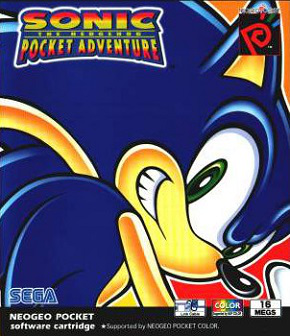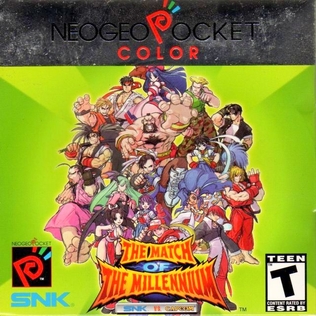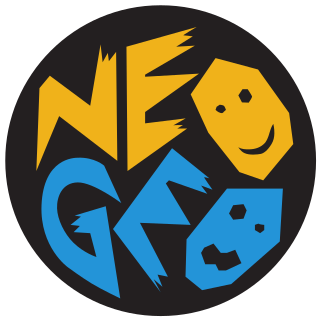
The Neo Geo Pocket (NGP) is a monochrome handheld game console released by SNK. It was the company's first handheld system and is part of the Neo Geo family. It debuted in Japan in late 1998 and was primarily sold in Japan and Hong Kong. The system and all five English games saw limited distribution in the West, where it could be ordered directly from SNK USA.

Crystalis is a 1990 action role-playing video game developed and published by SNK for the Nintendo Entertainment System. A port for the Game Boy Color developed by Nintendo Software Technology and published by Nintendo was released in 2000.

SNK Corporation is a Japanese video gaming and interactive entertainment company. It was founded in 1978 as Shin Nihon Kikaku by Eikichi Kawasaki and began by developing coin-op games. SNK is known for its Neo Geo arcade system on which the company produced many in-house games and now-classic franchises during the 1990s, including Aggressors of Dark Kombat, Art of Fighting, Fatal Fury, King of the Monsters, Metal Slug, Samurai Shodown, The King of Fighters, The Last Blade, Twinkle Star Sprites, and World Heroes; they continue to develop and publish new titles in some of these franchises on contemporary arcade and home platforms. Since the 2000s, SNK have diversified from their traditional arcade focus into pachislot machines, mobile game development, and recently character licensing.

The Neo Geo Pocket Color (NGPC) is a 16-bit handheld game console developed and manufactured by SNK, released on March 19, 1999 in Japan with international markets following in August that year. It is the successor to the Neo Geo Pocket, which was released in 1998 only in Japan and Hong Kong; the Color features a color display instead of a monochrome one, and is fully backward compatible.

Sonic the Hedgehog Pocket Adventure is a platform game developed and published by SNK for the Neo Geo Pocket Color in 1999. The game is based on Sonic the Hedgehog 2 (1992) for the Sega Genesis, borrowing much of the stage themes and gameplay elements, but featuring unique stage layouts, elements from other Genesis Sonic the Hedgehog games, and extra game modes. Sega's Yuji Naka and the rest of Sonic Team supervised over production.

SNK vs. Capcom: The Match of the Millennium is a crossover fighting game developed and published by SNK for the Neo Geo Pocket Color in 1999.

Ogre Battle Gaiden: Prince of Zenobia is a 2000 real-time tactical role-playing game developed and published by SNK for the Neo Geo Pocket Color. The game is a spin-off within the Ogre Battle series, originally created by Quest Corporation. The storyline takes place parallel to Ogre Battle: The March of the Black Queen, and follows the path of Prince Tristan of Zenobia during his quest to reclaim his kingdom. As with other Ogre Battle titles, the player controls squads of an army, moving to different parts of the map accomplishing tasks and battling armies encountered on the route. Choices made during the narrative impact the ending.
Sacnoth Inc., renamed Nautilus Inc. in 2002, was a Japanese video game developer based in Tokyo. The company was founded in April 1997 by Hiroki Kikuta with funding from SNK; its staff, including Kikuta, were veterans of Square. While their first releases were the Dive Alert games for the Neo Geo Pocket Color (NGPC), the company was founded to produce Koudelka, a role-playing video game for the PlayStation. The development of Koudelka was troubled due to creative differences between Kikuta and the rest of the staff, with Kikuta resigning as CEO following the game's release and being replaced by Jun Mihara. The company also released the NGPC game Faselei!.

Shinsetsu Samurai Spirits Bushidō Retsuden is a role-playing video game for SNK's Neo Geo CD system, which retells the events of Samurai Shodown and Samurai Shodown II in greater detail. It was ported to the Sega Saturn and PlayStation.

SNK Gals' Fighters is a fighting game for the Neo Geo Pocket Color, released in 2000. The game was ported to the Nintendo Switch in the eShop on April 29, 2020, and included as part of Neo Geo Pocket Color Selection Vol. 1 in 2021.

Dark Arms: Beast Buster 1999 is an action role-playing game released by SNK for the Neo-Geo Pocket Color in 1999. It is a spin-off follow-up to the SNK arcade shooter Beast Busters. The game was later re-released as part of Neo Geo Pocket Color Selection Vol. 1 in 2021.

Neo Geo is a brand of video game hardware developed by SNK.
ADK Corporation, formerly known as Alpha Denshi Corporation (アルファ電子株式会社), was a Japanese video game developer founded in 1980. ADK began as a developer of arcade games and is best known for their library of SNK Neo Geo titles, including for its home consoles, produced in partnership with SNK. Most notable among these are their fighting games and, in particular, the World Heroes series and Aggressors of Dark Kombat. The company closed with properties sold to SNK Playmore in 2003.

Ninja Master's: Haō Ninpō Chō,, is a ninja-themed 2D fighting game produced by ADK and originally released in 1996 for the Neo Geo arcade and home platform. Ninja Master's was the sixth and final fighting game produced by ADK, following the four games in the World Heroes series and Aggressors of Dark Kombat. It was later featured in the 2008 compilation ADK Damashii for the PlayStation 2. Ninja Master's was also re-released on the Neo-Geo X handheld system in 2012, and for the Virtual Console in 2013. In 2019 it was released as part of Arcade Archives developed by Japanese company Hamster. As of 2021, Ninja Master's was released worldwide on Nintendo Switch and Xbox One. The PS4 version remains exclusive to Asia but includes both Japanese and English releases.

Top Hunter: Roddy & Cathy is a side scrolling arcade beat 'em up platform game developed by SNK for the Neo Geo in 1994. It was also released on the Neo Geo CD, and the Wii Virtual Console. The game has been re-released as part of SNK Arcade Classics Vol. 1, on May 1, 2008, and in the ACA Neo Geo series on PlayStation 4 on January 10, 2018. Its development team consisted of former Irem staff members.

Faselei! is a tactical role-playing game developed by Sacnoth for the Neo Geo Pocket Color. It was published by SNK in 1999 in Japan and 2000 in the United Kingdom. A prospective North American release was cancelled when the console was pulled from sale. Following the exploits of the titular mech-piloting mercenary group during a civil war, the gameplay focuses on combat using mechs, with actions determined by commands imputed using a pool of action points.

Kikou Seiki Unitron (機甲世紀ユニトロン) is a video game. It was released in 2000 for the Neo Geo Pocket Color handheld game console. It is the sequel to Biomotor Unitron. It was only released in Japan.
SNK vs. Capcom: Card Fighters Clash is a series of SNK Playmore games between 1999 and 2006 for hand-held consoles. It is a digital collectible card game, spun off from the popular series of fighting games by SNK and Capcom, and also including references to many other kinds of games from both companies. The game uses cards based on Capcom and SNK characters from a variety of earlier games. The first two versions of this game were released for the Neo Geo Pocket Color, and a new version for the Nintendo DS was released in 2007.

Neo Geo Pocket Color Selection is a pair of video game compilations developed by SNK and Code Mystics. Each of the two volumes contain emulated versions of 10 games originally published by SNK between 1999 and 2000 for the company's short-lived Neo Geo Pocket Color handheld game console, including some featuring characters from fellow game developer Capcom. The first volume was released for Nintendo Switch in March 2021, followed by a release for Windows the following September. The second volume was released for both systems in November 2022.
















